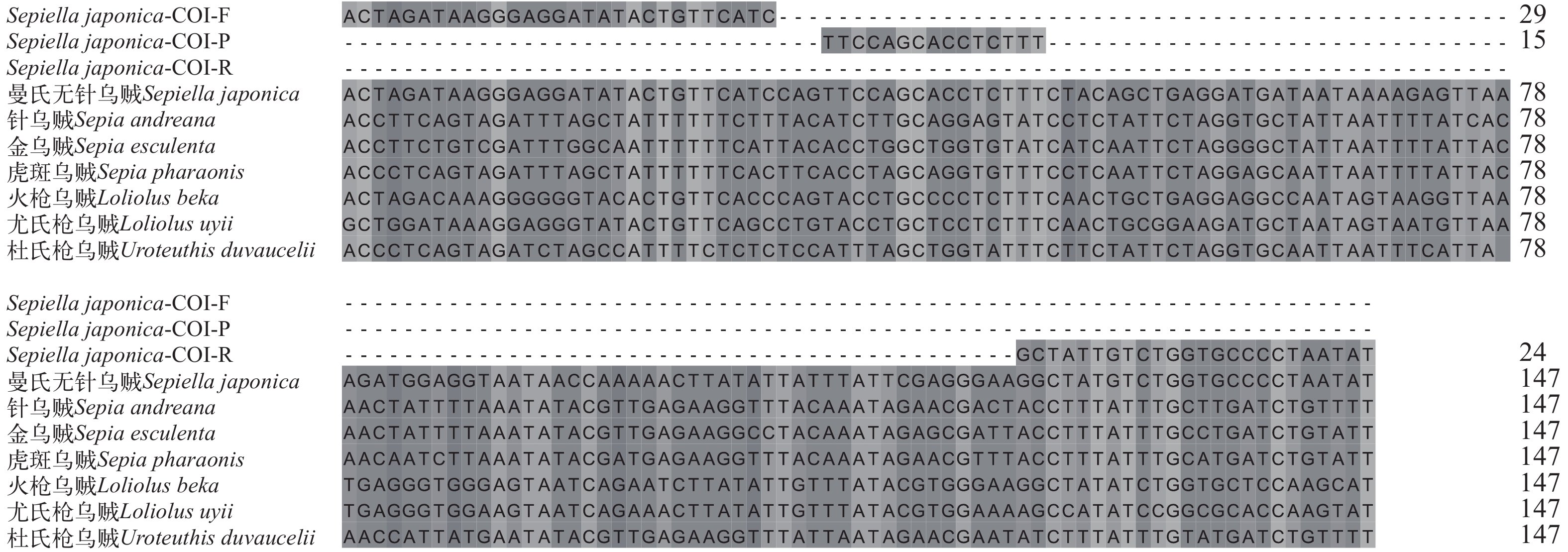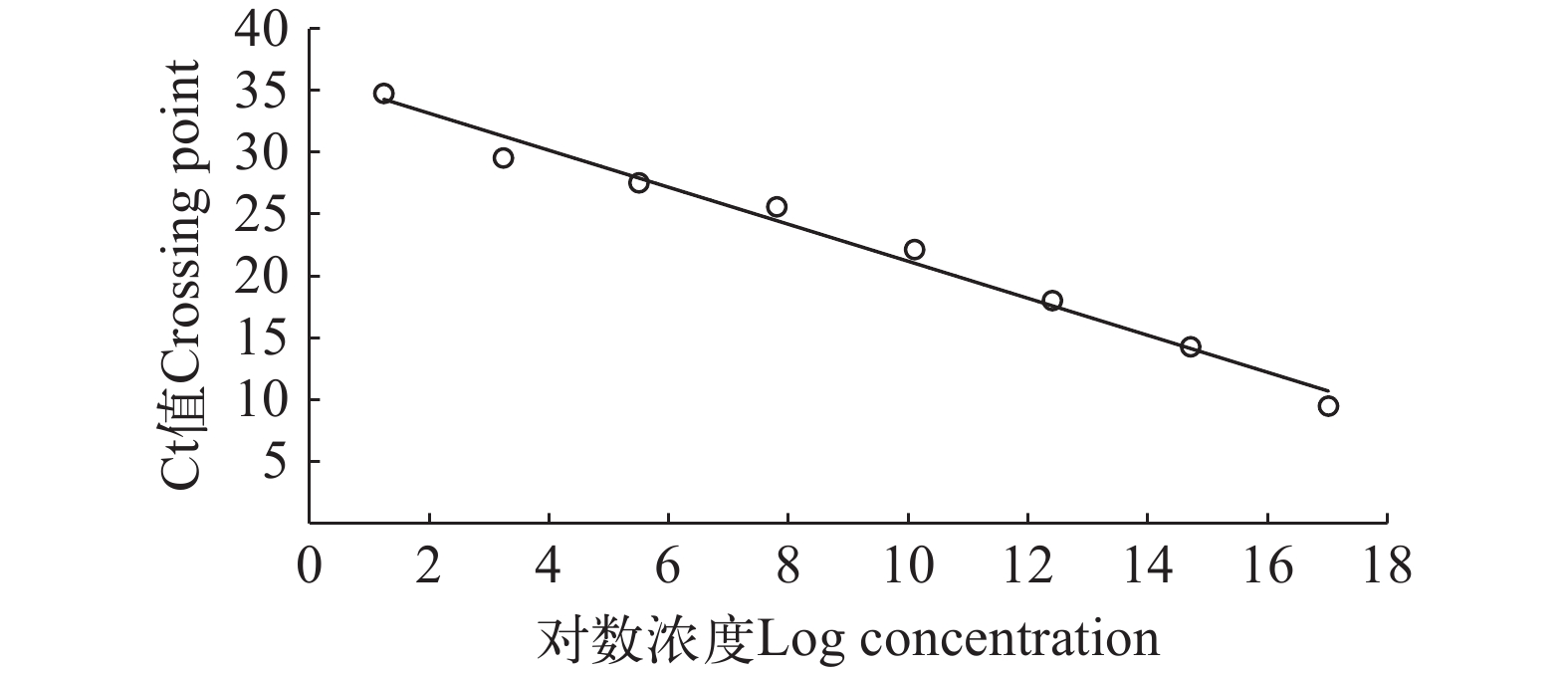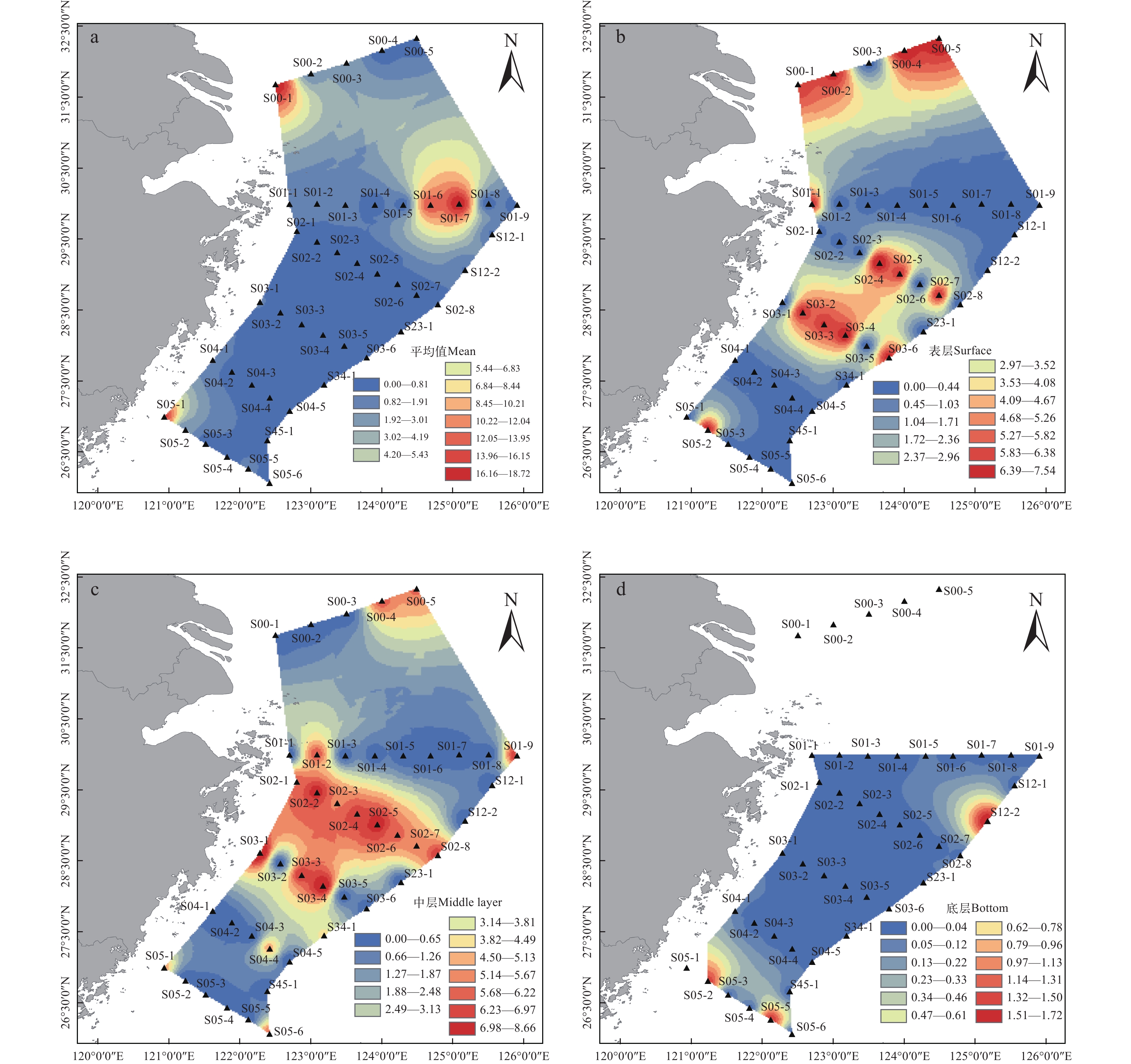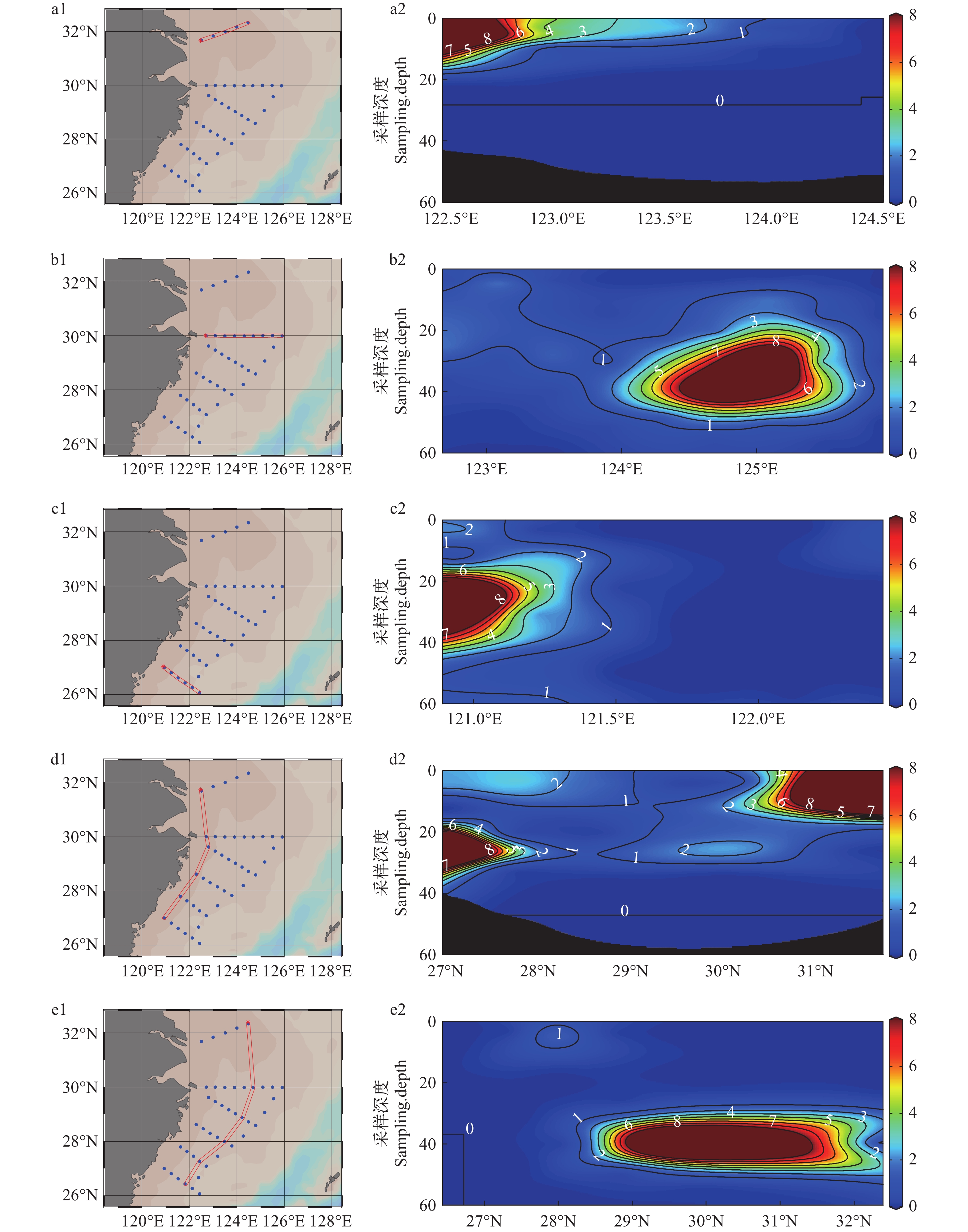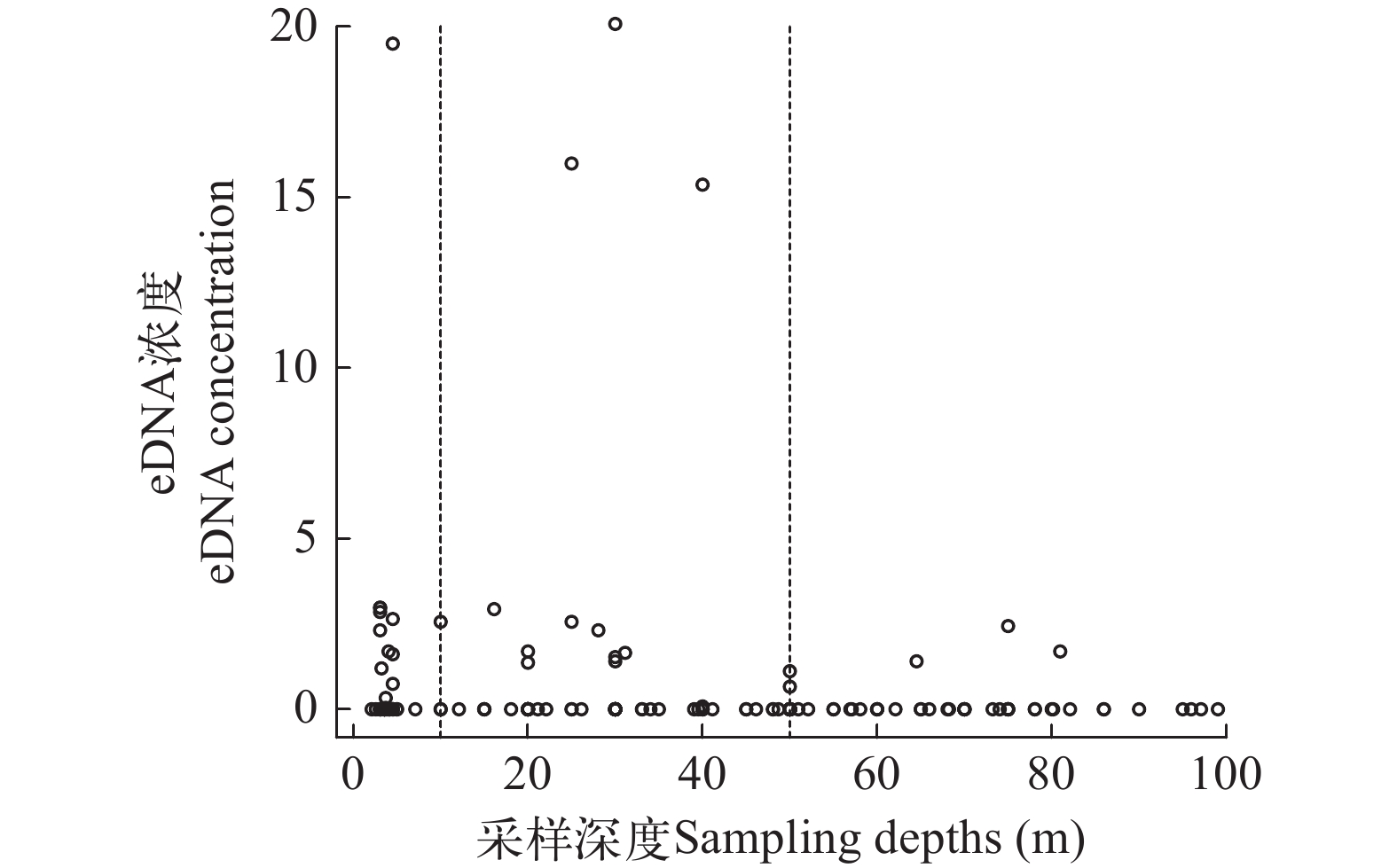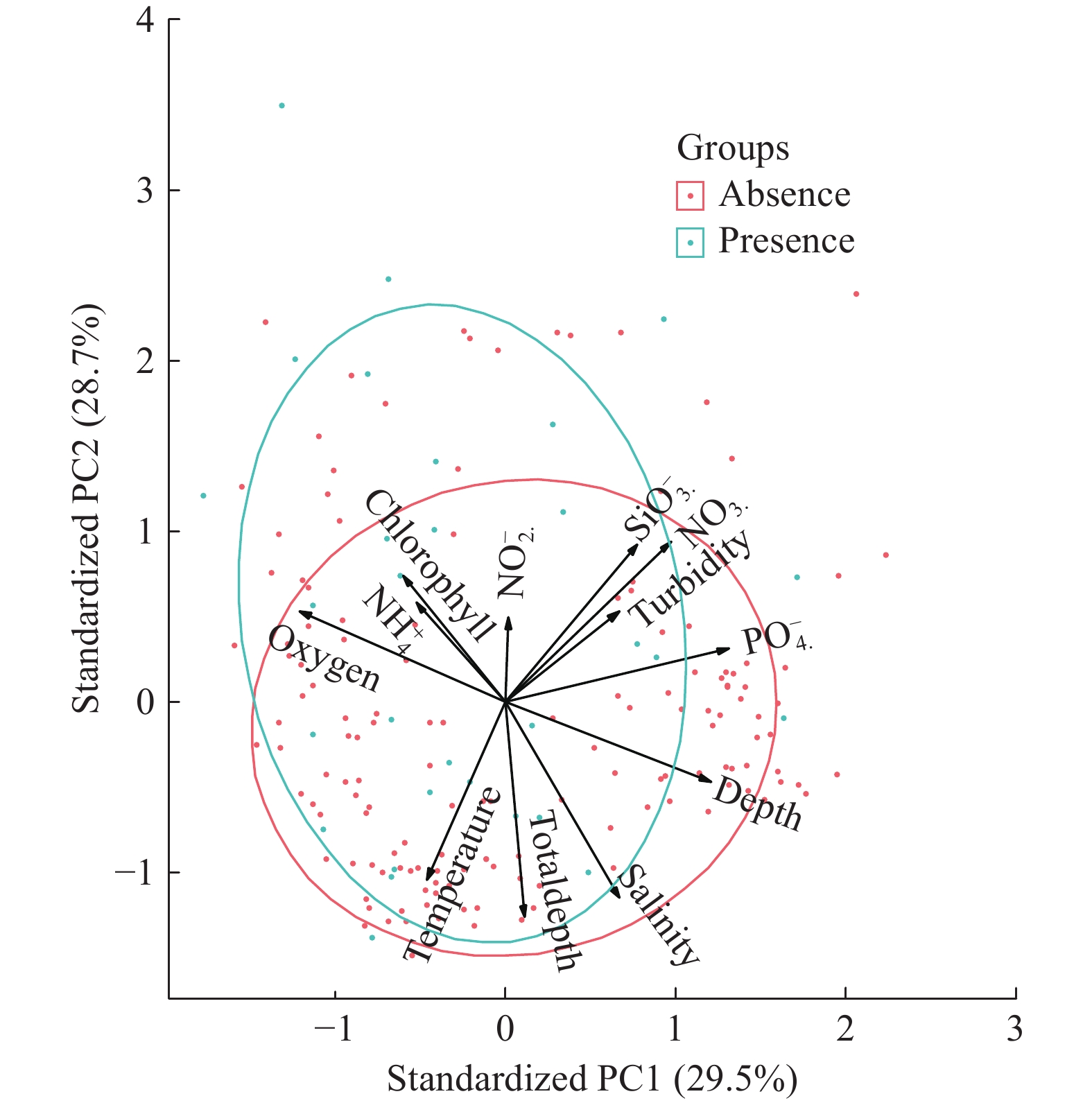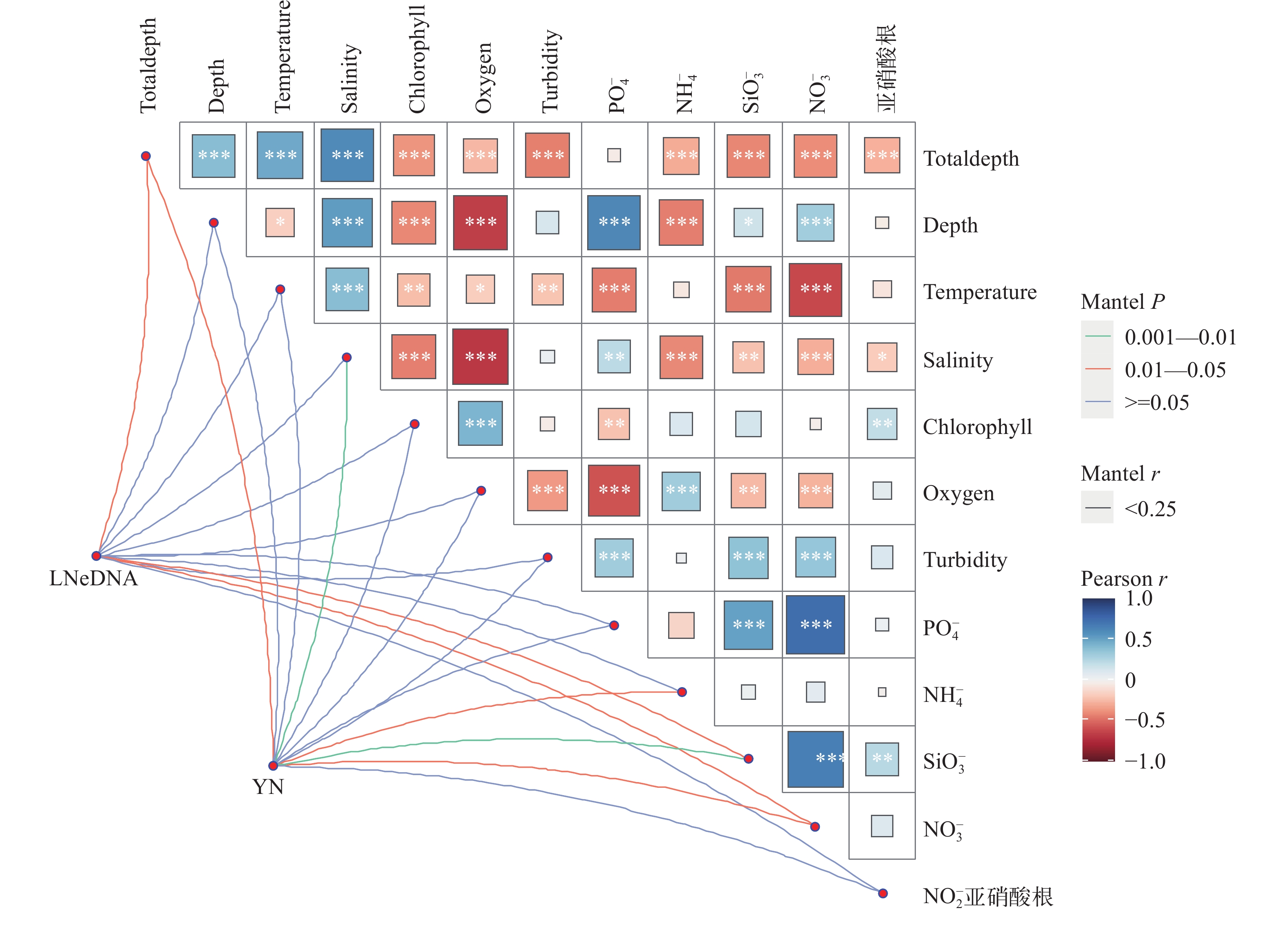DISTRIBUTION CHARACTERISTICS OF THE SPRINGTIME SEPIELLA JAPONICA IN THE EAST CHINA SEA BASED ON ENVIRONMENTAL DNA
-
摘要:
研究设计了曼氏无针乌贼(Sepiella japonica)的特异性引物和TaqMan探针, 采用eDNA方法对东海海域44个站位的175个水层样品进行了曼氏无针乌贼的水平(44个站位)和垂直分布(175份水样)分析, 并进行了曼氏无针乌贼eDNA与环境变量(总深度、采样深度、温度、盐度、溶氧量、浊度、叶绿素、${\rm{PO}}^{3-}_4 $、${\rm{NH}}^+_4 $、${\rm{SiO}}^{-}_3 $、${\rm{NO}}^-_3 $、${\rm{NO}}^-_2 $)的相关性分析。结果显示, 在调查海域曼氏无针乌贼的eDNA检出率为17.14%, 在各站位间无显著差异, 但在垂直分布上有显著差异(P<0.05)。在中表层水中检测到较高的曼氏无针乌贼eDNA浓度, 在深度大于81 m的海水中未检测到曼氏无针乌贼eDNA。此外, 曼氏无针乌贼的eDNA浓度(Ln([eDNA]+1))和存在/不存在(YNeDNA)受总深度、浊度、盐度、溶氧量、${\rm{SiO}}^{-}_3 $、${\rm{NH}}^+_4 $和${\rm{NO}}^-_3 $等环境变量的影响。研究证明了eDNA是一种可靠的物种调查方法, 可以作为传统资源调查的补充, 为进一步研究东海海域曼氏无针乌贼的资源分布及栖息地选择提供技术支持, 并为其资源修复和可持续利用提供参考依据。
Abstract:Species distribution monitoring and biomass assessment are crucial for the management and conservation of fishery resources. Compared to traditional fishery resource surveys, the environmental DNA (eDNA) method is an eco-friendly biological monitoring method that can monitor species without harming organisms. In this study, specific primers and TaqMan probes were designed to analyze the horizontal (44 stations) and vertical distribution (175 water samples) of Sepiella japonica in the East China Sea using eDNA. The eDNA concentrations were examined in relation to environmental variables, including total depth, sampling depth, temperature, salinity, dissolved oxygen, turbidity, chlorophyll, ${\rm{PO}}^{3-}_4 $, ${\rm{NH}}^+_4 $, ${\rm{SiO}}^{-}_3 $, ${\rm{NO}}^-_3 $, and ${\rm{NO}}^-_2 $. The results showed that the eDNA detection rate of S. japonica was 17.14%, with no significant difference among stations, but a significant difference in vertical distribution (P<0.05). High concentrations of S. japonica eDNA were detected in mid-surface water, while no eDNA was detected at depths deeper than 81 m. In addition, the eDNA concentration [Ln([eDNA]+1)] and presence/absence (YNeDNA) of S. japonica were affected by environmental factors such as total depth, turbidity, salinity, dissolved oxygen, silicate, ${\rm{NH}}^+_4 $, and Nitrate. Our study proves that eDNA is a reliable method, which can be used as a supplement to traditional resource investigation. It offers technical support for further research on the resource distribution and habitat selection of S. japonica in the East China Sea, and provides a reference for resource restoration and sustainable management efforts.
-
Keywords:
- Environmental DNA /
- East China Sea /
- Distribution /
- Sepiella japonica
-
曼氏无针乌贼(Sepiella japonica)俗称墨鱼、乌贼等, 属软体动物门(Mollusca)、头足纲(Cephalopoda)、十腕目(Decapodiformes)、乌贼科(Sepiidae)、无针乌贼属(Sepiella), 曾经是我国东海传统四大海产之一[1]。曼氏无针乌贼为印度−西太平洋广布种, 北到日本海, 南到马来群岛海域, 西到印度东海岸均有分布, 在我国主要分布在浙江近海和闽东海域[1]。曼氏无针乌贼曾是东海产量最高的头足类经济物种, 也是主要捕捞对象之一, 渔获量约占其全国渔获量的70%—80%, 在浙江省的年产量曾高达6万吨[2]。自20世纪70年代末以来, 由于过度捕捞和产卵场的破坏, 以及海洋生态环境的不断恶化, 导致东海海域的曼氏无针乌贼产量持续下降, 至20世纪90年代初基本绝迹[3]。曼氏无针乌贼是典型的暖水短距离洄游生物且生命周期较短, 其资源量完全依靠补充群体。为了恢复该物种资源, 相关研究人员陆续在浙江近海开展了曼氏无针乌贼的人工繁育和增养殖[4]、标记放流[5]、增殖放流效果评估[6]、产卵场修复[7]、实行伏季休渔和设置自然增殖保护区等措施。常态化的增殖放流等管理措施在曼氏无针乌贼资源修复上取得了一定的成效[8]。刘姝含等[9]对浙江中北部曼氏无针乌贼资源现状研究结果显示, 其资源量呈上升趋势, 但2017—2019年的群体规模仍未恢复至1980年的平均水平。目前, 有学者尝试曼氏无针乌贼标志放流, 以评价其资源增殖效果[5], 但因标志放流个体数量有限和放流群体的移动性较强等原因, 回捕标志个体仍存在诸多困难[6], 借助标志回捕手段难以实现放流效果评估。
有效的渔业资源管理和生物多样性保护需要准确的空间分布和种群状况信息[10, 11]。传统的渔业资源调查方法包括拖网捕捞、水下摄影、声纳探测、社会调查和文献检索等方法。直接捕捞法是渔业资源调查研究及渔业监测最常用的方法[12], 但这种方法存在生境破坏大、耗时长及成本高等缺点, 且需要运用专业的分类学知识来进行物种鉴定[13]。此外, 传统方法在特定时间(夏季休渔期)和特定区域(禁渔区和保护区)也不适用。近十年来, 环境DNA (Environmental DNA, eDNA)已成为环境保护和生物监测的有力工具。2019年Ikeda等[14]提出eDNA是评估水生生物分布的一种高效且高度灵敏的方法。研究表明, 即使在低生物量的情况下, 也可以通过eDNA方法实现对目标物种的检测[15, 16]。随着研究的不断深入, eDNA技术已被广泛应用于多个领域, 包括生物多样性分析[17]、入侵物种和珍稀濒危物种监测[18, 19]、鱼类产卵洄游[20]、生物量评估[21]等。研究表明, eDNA不仅可以用来检测特定区域内物种的存在与否, 而且特定物种的eDNA浓度与该物种的生物量之间存在正相关关系[22, 23]。例如, Sun等[24]在自然海域对中国对虾(Fenneropenaeus chinensis)同时进行了eDNA调查与传统拖网捕捞研究, 结果表明两种方法所反映的中国对虾生物量数据高度一致, 这进一步验证了使用eDNA浓度作为衡量生物量密度指标的有效性。Salter等[25]利用eDNA技术对大西洋鳕(Gadus morhua)种群进行了定量分析, 并将其结果与拖网捕捞数据进行了对比, 同样发现两者间存在一致性。然而, 值得注意的是, 海洋水体的分层现象限制了eDNA在垂直方向上的扩散[10], 此外, 不同物种甚至同一物种处于不同生命阶段的海洋生物往往展现出不同的栖息地偏好[26], 因此, 为确保准确反映目标物种的真实分布情况及丰度, 垂直采样非常必要。总体来看, eDNA技术在水生生物资源评估中具有高效、便捷和环境友好性等优点, 在渔业资源管理中具有很大的潜力, 尤其适用于大范围资源调查。
本研究旨在通过设计曼氏无针乌贼特异性引物和TaqMan探针, 利用eDNA方法监测曼氏无针乌贼在东海海域的水平和垂直分布, 并确定可能与其分布有关的环境变量, 以期为曼氏无针乌贼的资源评估和管理提供数据基础, 并对其资源修复和可持续利用提供参考依据。
1. 材料与方法
1.1 曼氏无针乌贼特异性引物和TaqMan探针的初步设计及验证
从美国国家生物技术信息中心(National Center for Biotechnology Information, NCBI)下载曼氏无针乌贼Sepiella japonica及其近缘物种(火枪乌贼Loliolus beka、尤氏枪乌贼Loliolus uyii、针乌贼Sepia andreana、金乌贼Sepia esculenta、虎斑乌贼Sepia pharaonis、杜氏枪乌贼Uroteuthis duvaucelii)等的线粒体基因组全序列, 使用Clustalw比对下载的COⅠ基因序列, 并用Primer Express软件初步设计曼氏无针乌贼的特异性引物和TaqMan探针, 由生工生物工程(上海)股份有限公司合成。
采用酚/氯仿抽提法提取曼氏无针乌贼及其近缘物种的基因组DNA, 并将其作为模板DNA, 通过实时荧光定量PCR (Quantitative Real-Time PCR, qPCR), 对初步设计的引物和TaqMan探针进行特异性检验。
1.2 质粒标准品的构建
使用验证成功的引物, 以提取的曼氏无针乌贼基因组DNA为模板, 进行PCR扩增。扩增反应为25 μL的体系: 12.5 μL Mix (内含buffer), 9.5 μL ddH2O, 1 μL模版DNA, 上下游引物各1 μL。扩增条件: 95℃预变性3min, 95℃变性30s, 55℃退火30s, 72℃延伸1min, 35个循环, 72℃终延伸5min。扩增产物经1.5%凝胶电泳后, 通过TA克隆[29]将目的片段连接到质粒载体上, 经过蓝白筛选后通过测序鉴定, 完成质粒标准品的构建, 测定质粒标准品浓度, 并计算拷贝数。以10倍浓度梯度稀释质粒标准品, 通过qPCR预实验选取合适的标准品区间, 并获取扩增效率。
1.3 水样采集与过滤
本研究于2019年5月, 在东海海域44个采样站位, 共采集175份海水样本, 具体采样站位信息(图 1)。海水样本采用24×20 L Niskin瓶, SBE 911 Plus CTD系统采集, 不同水深的海水样本保存在一次性无菌采样袋中。采样后24h内进行抽滤: 使用直径为47 mm、孔径为0.45 μm的玻璃纤维滤膜(上海兴亚, 中国)抽滤采集的水样, 每张滤膜过滤1 L海水; 每10个样品抽滤1 L纯净水作为阴性对照, 抽滤后的滤膜折叠后用铝箔纸包裹置于2 mL冻存管(上海生工生物工程股份有限公司)中, 置于–196℃的液氮速冻并保存。然后将冻存管带回实验室, 保存于–80℃超低温冰箱, 等待进一步提取eDNA。为防止样品间交叉污染, 所有的过滤设备在每次使用前后用10%的次氯酸溶液浸泡10min以去除残留的eDNA, 然后用自来水彻底冲洗, 最后用娃哈哈纯净水冲洗。抽滤不同的水样时更换新的一次性手套和口罩。
1.4 环境DNA提取
使用DNeasy Blood & Tissue试剂盒(Qiagen, 德国)从滤膜中提取总环境DNA[27]。用100 μL的AE缓冲液洗脱后, 使用OneStep PCR Inhibitor Removal试剂盒(ZYMO Research, 美国)去除抑制剂[28], 以提高eDNA的质量。将去除抑制剂后的总环境DNA存储于–80℃冰箱。
44个站位共计175份水样的环境变量包括总深度、采样深度、温度、盐度、溶氧量、浊度、叶绿素和营养物质(${\rm{PO}}^{3-}_4 $、${\rm{NH}}^+_4 $、${\rm{SiO}}^{-}_3 $、${\rm{NO}}^-_3 $、${\rm{NO}}^-_2 $), 由自然资源部第一海洋研究所测定并提供。
1.5 实时荧光定量PCR
以东海海域eDNA样品为模板, 使用曼氏无针乌贼特异性引物和TaqMan探针进行实时荧光定量PCR, 测定曼氏无针乌贼eDNA浓度。qPCR为20 μL的反应体系: 4.9 μL ddH2O、上下游引物各0.4 μL、TaqMan探针0.3 μL、10 μL 2×TaqMan Fast qPCR Master Mix和4 μL eDNA模板。阴性对照以ddH2O为模板。反应条件: 50℃孵育UNG酶2min, 95℃聚合酶激活2min, 94℃变性3s, 60℃退火30s, 共40个循环。使用的qPCR仪为7300Plus Real-Time PCR System。
1.6 统计分析和可视化
本研究根据样品采集水深分为三层(表层: 1—10 m, 中层: 10—50 m, 底层: 50—104 m), 以检验不同采样深度对eDNA垂直分布的影响。使用Kruskal-Wallis法进行曼氏无针乌贼eDNA浓度在各站位及不同水层间的差异分析。采用多元线性回归(Multiple linear regression, MLR)全子集回归法进行曼氏无针乌贼eDNA浓度及存在与否的预测分析。在MLR模型中, 12个环境变量(总深度、采样深度、温度、盐度、溶氧量、浊度、叶绿素、${\rm{PO}}^{3-}_4 $、${\rm{NH}}^+_4 $、${\rm{SiO}}^-_3 $、${\rm{NO}}^-_3 $、${\rm{NO}}^-_2 $)作为自变量, 曼氏无针乌贼eDNA对数浓度{Ln([eDNA]+1)}或曼氏无针乌贼存在/不存在(YNeDNA)分别作为因变量。采用“psych”软件包对175个海水样本的环境变量进行PCA分析。采用“link ET”软件包进行Mantel-Test检验, 分析曼氏无针乌贼eDNA分布和对数浓度即ln([eDNA]+1)与环境变量的相关性。所有统计分析均使用R软件3.5.3进行, 并利用ArcGIS 10.2和Ocean Data view 4对曼氏无针乌贼的采样站位和空间分布进行可视化处理。
2. 结果
2.1 引物和探针特异性验证结果
曼氏无针乌贼特异性引物和探针扩增了基于COⅠ基因的147 bp序列, 上游引物COⅠ-F序列为: 5′-ACTAGATAAGGGAGGATATACTGTTCATC-3′, 下游引物COⅠ-R序列为: 5′-ATATTAGGGGCACCAGACATAGC-3′, 探针COⅠ-P序列为: 5′6-FAM-TTCCAGCACCTCTTT-3′MGB。将曼氏无针乌贼引物和探针序列与其近缘物种进行序列比对, 结果显示该序列能够明显区分曼氏无针乌贼与其近缘物种(图 2)。在NCBI中将测序所得的序列进行相似性比对, 对比结果表明qPCR扩增产物与曼氏无针乌贼核苷酸序列相似性达100%。通过qPCR验证, 所设计的曼氏无针乌贼特异性引物和TaqMan探针仅能对曼氏无针乌贼进行检测, 其他近缘物种均未检出。
2.2 标准曲线的构建
曼氏无针乌贼的质粒标准品拷贝数为2.4482×108 copies/μL。将构建好的质粒稀释不同倍数后用荧光定量PCR仪扩增, 根据标准品浓度与扩增的Ct值生成标准曲线, 标准曲线方程为: y = –3.85x+38.403, 相关系数: R2=0.998, Y-intercept=38.403, 引物扩增效率为96.9%。标准曲线方程在稀释的质粒标准品DNA浓度范围内具有良好的线性关系, 表明建立的标准曲线能够准确反应曼氏无针乌贼COⅠ基因的扩增(图 3)。
2.3 曼氏无针乌贼的水平分布
44个站位中有23个站位(52.27%)检测出曼氏无针乌贼eDNA, 175份海水样品中有30份(17.14%)检测出曼氏无针乌贼eDNA。曼氏无针乌贼eDNA在不同水层的分布和浓度如图 4所示。在3个水层中, 中层的平均eDNA浓度(9.42×106 copies/L)高于其他2个水层(表层: 6.71×106 copies/L, 底层: 1.20×105 copies/L)。在同一水层中, 虽然曼氏无针乌贼不同站位间eDNA浓度在统计学上无显著差异(${\textit{χ}}^2 $=52.955, df=43, P=0.142>0.05), 但实际eDNA浓度和分布存在一定差异。曼氏无针乌贼eDNA浓度最高的是站位S01-7的中层, 浓度为5.32×108 copies/L; 其次是S00-1站位的表层, 浓度为2.95×108 copies/L。
![]() 图 4 东海曼氏无针乌贼eDNA水平分布a. 平均eDNA浓度; b. 表层eDNA浓度(1—10 m); c. 中层eDNA浓度(10—50 m); d. 底层eDNA浓度(50—104 m)Figure 4. Horizontal eDNA distributions of Sepiella japonica in the East China Seaa. average eDNA concentrations; b. eDNA concentrations in surface water (1—10 m); c. eDNA concentrations in middle layer water (10—50 m); d. eDNA concentrations in bottom water (50—104 m)
图 4 东海曼氏无针乌贼eDNA水平分布a. 平均eDNA浓度; b. 表层eDNA浓度(1—10 m); c. 中层eDNA浓度(10—50 m); d. 底层eDNA浓度(50—104 m)Figure 4. Horizontal eDNA distributions of Sepiella japonica in the East China Seaa. average eDNA concentrations; b. eDNA concentrations in surface water (1—10 m); c. eDNA concentrations in middle layer water (10—50 m); d. eDNA concentrations in bottom water (50—104 m)2.4 曼氏无针乌贼的垂直分布
曼氏无针乌贼的eDNA垂直分布如图 5和图 6所示, eDNA浓度以渐变颜色表示。不同水层曼氏无针乌贼eDNA浓度具有显著差异(${\textit{χ}}^2 $=6.9303, df=2, P=0.0312<0.05), 不同水层间曼氏无针乌贼eDNA存在显著差异(${\textit{χ}}^2 $=6.9995, df=43, P=0.030<0.05)。表层共有12个样品检测出曼氏无针乌贼(27.27%), 中层共有12个样品检测出曼氏无针乌贼(21.05%), 从底层水样中检测出6个样品存在曼氏无针乌贼(8.11%), 表层和中层的检出率均高于平均水平(17.14%), 结果显示曼氏无针乌贼eDNA主要分布于中表层海水中。
在S12-2站位的81 m水深处检测到分布最深的曼氏无针乌贼eDNA, 在深度大于81 m的海水中未检测到曼氏无针乌贼eDNA。在深度小于40 m的S00-1、S01-7、S01-6和S05-1站位中均检测出较高浓度的eDNA, 在深度大于50 m的海水中仅有3个站位(S12-2、S05-5和S05-2)检测到曼氏无针乌贼eDNA, 大部分eDNA浓度都较低(图 6)。
2.5 影响曼氏无针乌贼分布的环境变量
本研究采用全子集回归法进行多元线性回归(MLR), 评估环境变量是否可以用来预测样品中曼氏无针乌贼的eDNA丰度和存在与否。曼氏无针乌贼eDNA浓度预测结果: ln([eDNA]+1)=8.90070–0.04235×总深度+0.42049×叶绿素–1.28241×溶氧量–0.19122×浊度+1.01273×${\rm{NH}}^+_4 $(总深度, P<0.01; 叶绿素, P<0.05; 溶氧量, P<0.01; 浊度, P<0.05; ${\rm{NH}}^+_4 $, P<0.05), 曼氏无针乌贼eDNA存在/不存在预测结果如下: YNeDN=4.606004–0.105668×盐度–0.179952×溶氧量–0.019568×浊度–0.316771×$ \rm{PO}_4^{3-} $+0.014525×${\rm{SiO}}^-_3 $(盐度, P<0.01; 溶氧量, P<0.01; 浊度, P<0.05; $ \rm{PO}_4^{3-} $, P<0.01; ${\rm{SiO}}^-_3 $, P<0.01)。
使用12个环境变量进行PCA分析(图 7), 向量的大小对应每个变量的贡献度。12个环境变量被简化成两个主成分, PC1 (29.5%)主要由${\rm{NO}}^-_3 $、${\rm{SiO}}^-_3 $、${\rm{PO}}^{3-}_4 $和温度组成, PC2 (28.7%)主要由盐度、溶氧量、采样深度、总深度和叶绿素组成, 因此PC1主要代表营养, PC2主要代表站位和水层。如图 6所示, 曼氏无针乌贼eDNA存在和不存在的分组上有很大程度的重叠, 表明除环境变量以外的其他因素也可能影响曼氏无针乌贼的分布。
Mantel检验分析结果表明(图 8), 曼氏无针乌贼eDNA浓度和分布与环境变量存在相关性(R<0.25)。eDNA对数浓度与总深度、${\rm{SiO}}^-_3 $和${\rm{NO}}^-_3 $含量具有显著相关性(P<0.05), 曼氏无针乌贼eDNA分布与盐度和${\rm{SiO}}^-_3 $极显著相关(P<0.01), 与总深度、${\rm{NH}}^+_4 $和${\rm{NO}}^-_3 $显著相关(P<0.05)。综上, 曼氏无针乌贼eDNA浓度和存在/不存在与总深度、盐度、${\rm{SiO}}^-_3 $、${\rm{NH}}^+_4 $和${\rm{NO}}^-_3 $含量等环境变量具有相关性。
3. 讨论
3.1 曼氏无针乌贼eDNA水平分布的差异
本研究设计了曼氏无针乌贼的特异性引物和TaqMan探针, 采用eDNA方法进行了春季东海海域曼氏无针乌贼的水平和垂直分布特征研究。eDNA所反映的曼氏无针乌贼在东海近海海域的水平分布与2019年春季资源调查结果基本一致[9]。曼氏无针乌贼是一种暖水性短距离洄游生物, 曾是中国传统海洋渔业四大海产之一[29, 30]。越冬的曼氏无针乌贼亲体在4月开始从东海近海向沿岸水域迁徙产卵, 受精卵在自然条件下孵化时间约为1个月, 产卵后的亲体洄游至东海开阔海域取食, 孵化后的幼体在产卵场周边水域索饵成长, 曼氏无针乌贼的产卵场多位于禁渔线西南部近岸水域[1, 31]。浙江中北部近海曼氏无针乌贼资源调查结果显示, 2019春季(4月)曼氏无针乌贼主要分布在近海, 在不同水层的海域中均有分布, 出现位置为122°E、30°N舟山渔场中部海域附近[9]。Yamamoto等[32]将eDNA浓度反映的舞鹤湾日本竹筴鱼(Trachurus japonicus)生物量和回声探测技术监测到的生物量进行了比较, 结果表明, eDNA浓度可以反映150 m内的鱼类生物量。Masaaki等[33]在海洋环境中验证了eDNA定量分析的准确性, 证明了从eDNA浓度推断的鱼类种群密度与使用回声探测仪方法获得的鱼类种群密度相当。在本研究中, eDNA反映的曼氏无针乌贼在东海近海海域的分布与2019年春季资源调查结果基本一致, 证明了eDNA是有效的物种监测工具, 可用于曼氏无针乌贼资源评估, 尤其适用于机轮拖网禁渔区和禁渔期。
3.2 曼氏无针乌贼eDNA垂直分布的差异
东海海域曼氏无针乌贼eDNA垂直分布差异显著, 结果显示三个水层都检测到了曼氏无针乌贼eDNA的存在, 但底层的检出率较低。东海区近海曼氏无针乌贼主要作东南至西北、浅水至深水间的短距离洄游, 春季曼氏无针乌贼从深水区游向近岸产卵场产卵[1, 34]。由于本研究采样时间正值曼氏无针乌贼产卵期和幼乌贼破卵而出的时期, 孵化后的幼乌贼缺乏运动能力随波逐流, 因此在表层水中检测到的eDNA极有可能来自幼乌贼。在深度大于81 m的海水中未检测到曼氏无针乌贼eDNA, 在深度小于50 m的海水中检测到绝大多数曼氏无针乌贼eDNA。eDNA的垂直分布取决于物种分布的水层[35]与eDNA的扩散和降解率[10]。在复杂的海洋生态环境中, eDNA浓度和分布受生物因素(生物量密度、生长阶段)和非生物因素(运输、扩散、降解)的影响[36]。收集水样时应考虑到目标物种的产卵场和栖息地偏好, 在未来的其他海洋生物调查中, 需要同时考虑到水平和垂直分布, 从而提供更为精确的分布和丰度, 以便更好地评估渔业资源。
3.3 环境因子与曼氏无针乌贼eDNA浓度的相关性
海洋生物的生存和生长与海洋环境密不可分, 环境因素在渔业资源调查中起着关键性的作用[37]。在预测的回归方程中, 曼氏无针乌贼eDNA浓度与总深度和溶氧量极显著相关(P<0.01), eDNA存在/不存在与盐度、溶氧量及$ \rm{PO}_4^{3-} $和${\rm{SiO}}^-_3 $含量极显著相关(P<0.01)。$ \rm{PO}_4^{3-} $的浓度在0—1.92 mg/L, ${\rm{NO}}^-_3 $的浓度在0—17.73 mg/L, $ \rm{PO}_4^{3-} $和${\rm{NO}}^-_3 $的浓度都处于正常水平。特定浓度的$ \rm{PO}_4^{3-} $和${\rm{NO}}^-_3 $有利于藻类生长, 提高初级生产力, 并直接或间接提供饵料[38]。盐度也是影响曼氏无针乌贼分布和丰度的重要因素, 曼氏无针乌贼生的最适盐度的分布范围是33.5‰—34.5‰[9]。鱼类种群的空间分布及其与环境的关系一直是渔业生态学研究的热点[39]。因此, 在今后的渔业资源调查中, 通过预测环境因子与调查物种的回归方程, 推断不同环境条件下的分布格局, 从而获得目标物种的空间分布特征及影响因素, 便于更有针对性的调查。PCA分析结果表明, 除12个环境变量外, 其他因素也有可能影响曼氏无针乌贼的分布和资源量。Mantel检验分析结果进一步验证了回归方程的预测结果。
我国东海海域头足类资源丰富, 关于东海头足类资源开发利用现状也有较多报道[40, 41]。曼氏无针乌贼作为曾经东海海域的头足类主要经济物种, 其研究主要集中在近岸海域, 缺乏外海区域的研究, eDNA作为一种可靠的环境友好型方法, 可以作为传统资源调查的补充方法, 补充东海外海海域的相关数据, 进一步研究东海海域曼氏无针乌贼的资源分布和生物量密度, 可为曼氏无针乌贼渔业资源评估和管理提供数据基础。此外, 有研究表明通过标志回捕法难以实现对增殖放流效果的有效评估[6], eDNA技术凭借其不会对生物造成伤害的优点, 有望成为曼氏无针乌贼增殖放流效果评估的一种补充手段。
-
图 4 东海曼氏无针乌贼eDNA水平分布
a. 平均eDNA浓度; b. 表层eDNA浓度(1—10 m); c. 中层eDNA浓度(10—50 m); d. 底层eDNA浓度(50—104 m)
Figure 4. Horizontal eDNA distributions of Sepiella japonica in the East China Sea
a. average eDNA concentrations; b. eDNA concentrations in surface water (1—10 m); c. eDNA concentrations in middle layer water (10—50 m); d. eDNA concentrations in bottom water (50—104 m)
-
[1] 周永东, 李圣法. 东海区主要经济种类三场一通道及保护区图集 [M]. 北京: 海洋出版社, 2018.] Zhou Y D, Li S F. Atlas of Main Economic Types, Three Fields, One Channel and Protected Areas in the East China Sea [M]. Beijing: Ocean Press, 2018. [
[2] 倪正雅, 徐汉祥. 浙江近海乌贼资源评估及乌贼渔业管理 [J]. 海洋渔业, 1986, 8(2): 51-54.] Ni Z Y, Xu H X. Evaluation of squid resources and squid fishery management in Zhejiang offshore [J]. Marine Fisheries, 1986, 8(2): 51-54. [
[3] 李永祺, 唐学玺. 海洋恢复生态学 [M]. 青岛: 中国海洋大学出版社, 2016.] Li Y Q, Tang X X. Marine Restoration Ecology [M]. Qingdao: China Ocean University Press, 2016. [
[4] 常抗美, 吴常文, 吕振明, 等. 曼氏无针乌贼增养殖开发与利用的研究进展 [J]. 中国水产, 2008(3): 55-56.] doi: 10.3969/j.issn.1002-6681.2008.03.035 Chang K M, Wu C W, Lü Z M, et al. Research progress on the development and utilization of Sepiella maindroni [J]. China Fisheries, 2008(3): 55-56. [ doi: 10.3969/j.issn.1002-6681.2008.03.035
[5] 梁君, 王伟定, 徐汉祥, 等. 曼氏无针乌贼荧光染色标志方法研究 [J]. 水产学报, 2013, 37(6): 864-870.] doi: 10.3724/SP.J.1231.2013.38443 Liang J, Wang W D, Xu H X, et al. A fluorescent staining method for marking the cuttlefish (Sepiella japonica) [J]. Journal of Fisheries of China, 2013, 37(6): 864-870. [ doi: 10.3724/SP.J.1231.2013.38443
[6] 徐开达, 周永东, 王洋, 等. 浙北近海曼氏无针乌贼增殖放流效果评估 [J]. 中国水产科学, 2018, 25(3): 654-662.] doi: 10.3724/SP.J.1118.2018.17412 Xu K D, Zhou Y D, Wang Y, et al. Effect and assessment of enhancement release of Sepiella maindroni in the northern coastal water of Zhejiang [J]. Journal of Fishery Sciences of China, 2018, 25(3): 654-662. [ doi: 10.3724/SP.J.1118.2018.17412
[7] 吴常文, 董智勇, 迟长凤, 等. 曼氏无针乌贼(Sepiella maindroni)繁殖习性及其产卵场修复的研究 [J]. 海洋与湖沼, 2010, 41(1): 39-46.] doi: 10.11693/hyhz201001005005 Wu C W, Dong Z Y, Chi C F, et al. Reproductive and spawning habits of Sepiella maindroni of Zhejiang, China [J]. Oceanologia et Limnologia Sinica, 2010, 41(1): 39-46. [ doi: 10.11693/hyhz201001005005
[8] 陈伟峰, 叶深, 余玥, 等. 浙南近海头足类种类组成及生态位分析 [J]. 水生生物学报, 2021, 45(2): 428-435.] doi: 10.7541/2021.2018.262 Chen W F, Ye S, Yu Y, et al. Analysis on species composition and ecological niche of cephalopod in the coastal area of south Zhejiang [J]. Acta Hydrobiologica Sinica, 2021, 45(2): 428-435. [ doi: 10.7541/2021.2018.262
[9] 刘姝含, 刘连为, 徐开达, 等. 浙江中北部近海曼氏无针乌贼资源现状 [J]. 浙江海洋大学学报(自然科学版), 2022, 41(4): 286-293.] Liu S H, Liu L W, Xu K D, et al. The resource status of Sepiella maindroni in the coastal areas of north and central Zhejiang [J]. Journal of Zhejiang Ocean University (Natural Science), 2022, 41(4): 286-293. [
[10] Murakami H, Yoon S, Kasai A, et al. Dispersion and degradation of environmental DNA from caged fish in a marine environment [J]. Fisheries Science, 2019, 85(2): 327-337. doi: 10.1007/s12562-018-1282-6
[11] Evans N T, Lamberti G A. Freshwater fisheries assessment using environmental DNA: a primer on the method, its potential, and shortcomings as a conservation tool [J]. Fisheries Research, 2018(197): 60-66. doi: 10.1016/j.fishres.2017.09.013
[12] Lacoursière-Roussel A, Côté G, Leclerc V, et al. Quantifying relative fish abundance with eDNA: a promising tool for fisheries management [J]. Journal of Applied Ecology, 2016, 53(4): 1148-1157. doi: 10.1111/1365-2664.12598
[13] Kirtane A, Wieczorek D, Noji T, et al. Quantification of Environmental DNA (eDNA) shedding and decay rates for three commercially harvested fish species and comparison between eDNA detection and trawl catches [J]. Environmental DNA, 2021, 3(6): 1142-1155. doi: 10.1002/edn3.236
[14] Ikeda K, Doi H, Terui S, et al. Estimating native and invasive crayfish distributions in relation to culvert barriers with environmental DNA [J]. Freshwater Science, 2019, 38(3): 629-641. doi: 10.1086/704998
[15] Xin Y, Guo Y, Sun M, et al. Optimal conditions to quantify the relationship between eDNA concentration and biomass in Acanthopagrus latus [J]. Water, 2022, 14(21): 3521. doi: 10.3390/w14213521
[16] Wilcox T M, McKelvey K S, Young M K, et al. Understanding environmental DNA detection probabilities: a case study using a stream-dwelling char Salvelinus fontinalis [J]. Biological Conservation, 2016(194): 209-216. doi: 10.1016/j.biocon.2015.12.023
[17] Li C, Long H, Yang S, et al. eDNA assessment of pelagic fish diversity, distribution, and abundance in the central Pacific Ocean [J]. Regional Studies in Marine Science, 2022(56): 102661. doi: 10.1016/j.rsma.2022.102661
[18] Kalogianni E, Kalaitzakis N, Vardakas L, et al. Nationwide tracing of two top freshwater fish invaders in Greece using environmental DNA sampling [J]. Diversity, 2023, 16(1): 28. doi: 10.3390/d16010028
[19] Budd A M, Schils T, Cooper M K, et al. Monitoring threatened species with environmental DNA and open ecological data: local distribution and habitat preferences of scalloped hammerhead sharks (Sphyrna lewini) [J]. Biological Conservation, 2023(278): 109881. doi: 10.1016/j.biocon.2022.109881
[20] Takeuchi A, Watanabe S, Yamamoto S, et al. First use of oceanic environmental DNA to study the spawning ecology of the Japanese eel Anguilla japonica [J]. Marine Ecology Progress Series, 2019(609): 187-196. doi: 10.3354/meps12828
[21] Doi H, Inui R, Akamatsu Y, et al. Environmental DNA analysis for estimating the abundance and biomass of stream fish [J]. Freshwater Biology, 2017, 62(1): 30-39. doi: 10.1111/fwb.12846
[22] Tillotson M D, Kelly R P, Duda J J, et al. Concentrations of environmental DNA (eDNA) reflect spawning salmon abundance at fine spatial and temporal scales [J]. Biological Conservation, 2018(220): 1-11. doi: 10.1016/j.biocon.2018.01.030
[23] Itakura H, Wakiya R, Yamamoto S, et al. Environmental DNA analysis reveals the spatial distribution, abundance, and biomass of Japanese eels at the river-basin scale [J]. Aquatic Conservation: Marine and Freshwater Ecosystems, 2019, 29(3): 361-373. doi: 10.1002/aqc.3058
[24] Sun S, Lyu D, Qian T, et al. Evaluate the biomass of Fenneropenaeus chinensis from the southern coast of Shandong peninsula using eDNA [J]. Water, 2023, 15(2): 342. doi: 10.3390/w15020342
[25] Salter I, Joensen M, Kristiansen R, et al. Environmental DNA concentrations are correlated with regional biomass of Atlantic cod in oceanic waters [J]. Communications Biology, 2019(2): 461. doi: 10.1038/s42003-019-0696-8
[26] Tamario C, Sunde J, Petersson E, et al. Ecological and evolutionary consequences of environmental change and management actions for migrating fish [J]. Frontiers in Ecology and Evolution, 2019(7): 271. doi: 10.3389/fevo.2019.00271
[27] Wang X Y, Zhang H B, Lu G Q, et al. Detection of an invasive species through an environmental DNA approach: the example of the red drum Sciaenops ocellatus in the East China Sea [J]. The Science of the Total Environment, 2022(815): 152865. doi: 10.1016/j.scitotenv.2021.152865
[28] Minegishi Y, Wong M K S, Kanbe T, et al. Spatiotemporal distribution of juvenile chum salmon in Otsuchi Bay, Iwate, Japan, inferred from environmental DNA [J]. PLoS One, 2019, 14(9): e0222052. doi: 10.1371/journal.pone.0222052
[29] 陈新军, 王尧耕, 钱卫国. 中国近海重要经济头足类资源与渔业 [M]. 北京: 科学出版社, 2013.] Chen X J, Wang Y G, Qian W G. Important Economic Cephalopod Resources and Fisheries in China Offshore [M]. Beijing: Science Press, 2013. [
[30] 吴常文, 周超, 郭宝英, 等. 浙江近海曼氏无针乌贼(Sepiella maindroni)繁殖生物学特性变化研究 [J]. 海洋与湖沼, 2012, 43(4): 689-694.] doi: 10.11693/hyhz201204001001 Wu C W, Zhou C, Guo B Y, et al. Study on changes in reproductive biology characteristics of Sepiella maindroni offshore Zhejiang [J]. Oceanologia et Limnologia Sinica, 2012, 43(4): 689-694. [ doi: 10.11693/hyhz201204001001
[31] 朱岚倩, 郭浩宇, 张宗航, 等. 野生和养殖曼氏无针乌贼亲体形态、生化组分及其胚胎发育的比较 [J]. 水产学报, 2022, 46(8): 1403-1413.] Zhu L Q, Guo H Y, Zhang Z H, et al. Comparison between the wild and hatchery-reared Sepiella japonica in morphology, biochemical composition and embryonic development [J]. Journal of Fisheries of China, 2022, 46(8): 1403-1413. [
[32] Yamamoto S, Minami K, Fukaya K, et al. Environmental DNA as a ‘snapshot’ of fish distribution: a case study of Japanese jack mackerel in maizuru bay, sea of Japan [J]. PLoS One, 2016, 11(3): e0149786. doi: 10.1371/journal.pone.0149786
[33] Sato M, Inoue N, Nambu R, et al. Quantitative assessment of multiple fish species around artificial reefs combining environmental DNA metabarcoding and acoustic survey [J]. Scientific Reports, 2021, 11(1): 19477. doi: 10.1038/s41598-021-98926-5
[34] 吴常文, 赵淑江, 徐蝶娜. 舟山渔场针乌贼(Sepia andreana)的生物学特性及其渔场分布变迁 [J]. 海洋与湖沼, 2006, 37(3): 231-237.] doi: 10.3321/j.issn:0029-814X.2006.03.007 Wu C W, Zhao S J, Xu D N. Biology and resource of cuttlefish Sepia andreana in Zhoushan fishing area [J]. Oceanologia et Limnologia Sinica, 2006, 37(3): 231-237. [ doi: 10.3321/j.issn:0029-814X.2006.03.007
[35] Jeunen G J, Lamare M D, Knapp M, et al. Water stratification in the marine biome restricts vertical environmental DNA (eDNA) signal dispersal [J]. Environmental DNA, 2020, 2(1): 99-111. doi: 10.1002/edn3.49
[36] Hansen B K, Bekkevold D, Clausen L W, et al. The sceptical optimist: challenges and perspectives for the application of environmental DNA in marine fisheries [J]. Fish and Fisheries, 2018, 19(5): 751-768. doi: 10.1111/faf.12286
[37] Mukherjee S, Chaudhuri A, Kundu N, et al. Comprehensive analysis of fish assemblages in relation to seasonal environmental variables in an estuarine river of Indian sundarbans [J]. Estuaries and Coasts, 2013, 36(1): 192-202. doi: 10.1007/s12237-012-9558-z
[38] Malzahn A M, Hantzsche F, Schoo K L, et al. Differential effects of nutrient-limited primary production on primary, secondary or tertiary consumers [J]. Oecologia, 2010, 162(1): 35-48. doi: 10.1007/s00442-009-1458-y
[39] Hu J H, Tsai W P, Cheng S T, et al. Explore the relationship between fish community and environmental factors by machine learning techniques [J]. Environmental Research, 2020(184): 109262. doi: 10.1016/j.envres.2020.109262
[40] 朱文斌, 薛利建, 卢占晖, 等. 东海南部海域头足类群落结构特征及其与环境关系 [J]. 海洋与湖沼, 2014, 45(2): 436-442.] doi: 10.11693/hyhz20121228001 Zhu W B, Xue L J, Lu Z H, et al. Cephalopod community structure and its relationship with environmental factors in the southern East China Sea [J]. Oceanologia et Limnologia Sinica, 2014, 45(2): 436-442. [ doi: 10.11693/hyhz20121228001
[41] 严利平, 李建生. 东海区经济乌贼类资源量评估 [J]. 海洋渔业, 2004, 26(3): 189-192.] doi: 10.3969/j.issn.1004-2490.2004.03.006 Yan L P, Li J S. Assessment of commercial cuttlefish biomass in the East China Sea [J]. Marine Fisheries, 2004, 26(3): 189-192. [ doi: 10.3969/j.issn.1004-2490.2004.03.006



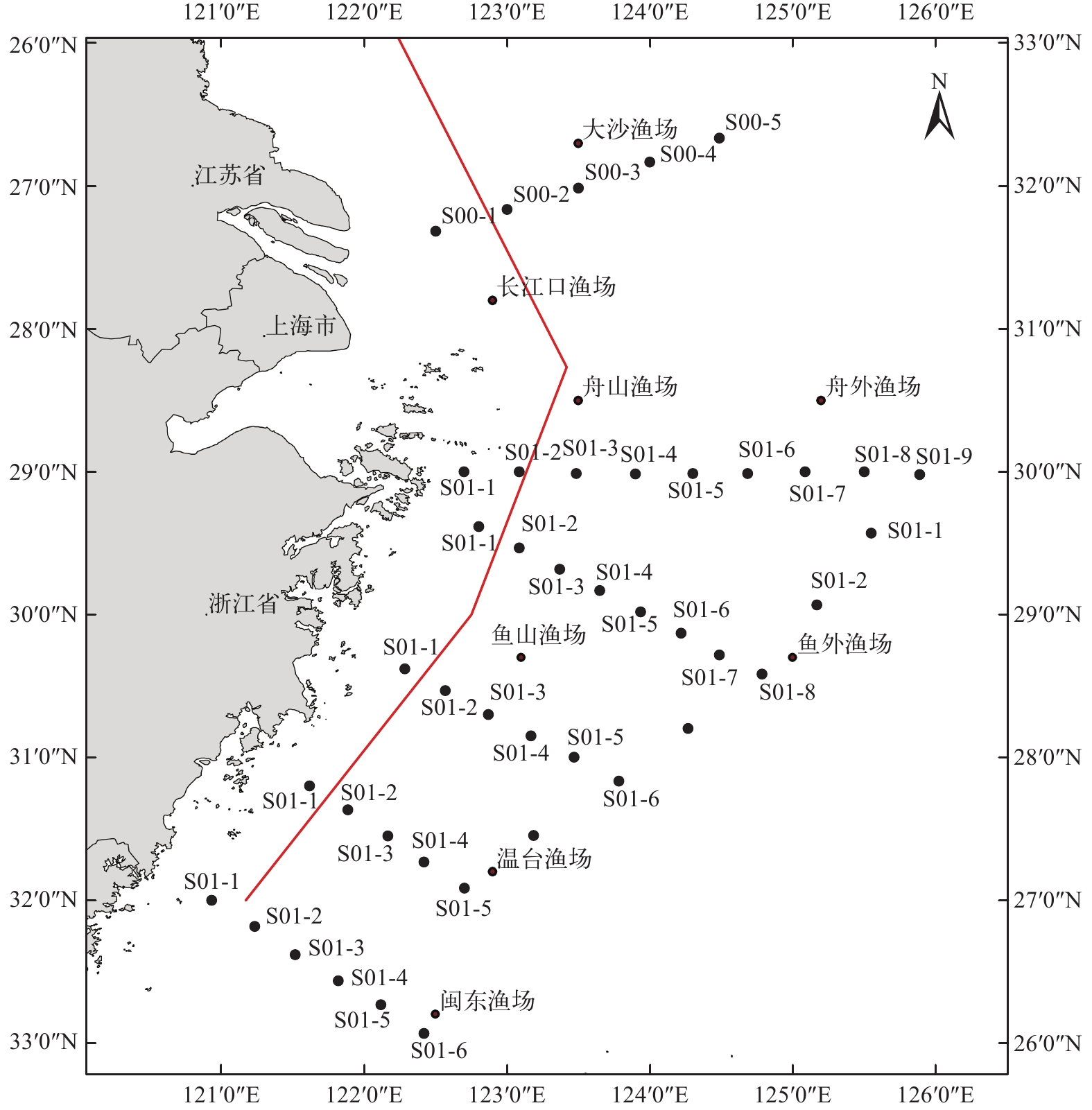
 下载:
下载:
